by Carolyn Edlund
Artist Preston Zeller turned a tragic event into a force for good.
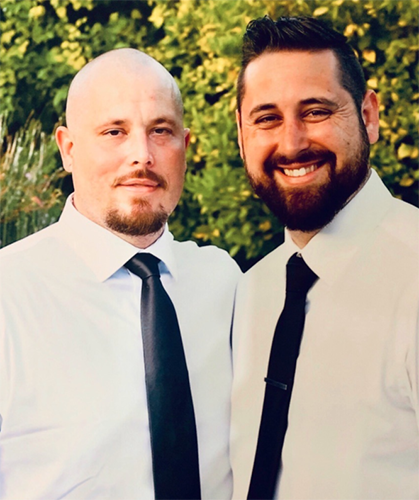
Preston Zeller (right) with his brother Colin Zeller at a formal event in Palm Springs, CA in May 2018
In February of 2019, Preston Zeller lost his brother Colin unexpectedly to a drug overdose. Colin, age 35, was a decorated U.S. Army vet, having served two tours in Iraq and Afghanistan. He left behind a wife, his parents and siblings. Zeller received the news of his brother’s sudden passing in a phone call after a meeting at work.
The tragic news inspired Zeller to embrace a year-long commitment of processing grief through painting. As an artist working in several disciplines, including music, photography, film, and fine art, he has often pondered the meaning behind his creative works and his motivation. This has ranged from being purely fluid (in the moment), to be relational, about God, nature, and general life experiences.
He feels that people often create from a source of pain because it’s the most visceral way of expression. We recently had a conversation about his experience, what he has learned, and how he is turning it into a project to reach out to others dealing with grief.
AS: What compelled you to respond to your brother’s death by creating art?
PZ: Death (or nearness thereof) is perhaps the only event that forces a person to question nearly everything. In my case, I immediately began to quantify the external loss of his presence in everyone’s lives. His friends had lost a confidant and coherent stitch in their timeline of life. My sister-in-law was now a widow, and my parents no longer had their firstborn. My sister and I resolved to be just the two of us instead of enjoying the camaraderie of our older brother.
It was several weeks after his passing until I was able to settle down from all of the travel, writing and delivering his eulogy, the memorial service, and the aftermath of a young life suddenly lost. That was taxing enough, but I knew I had to return to the canvas to pour out much of what I had been feeling and processing. With a family to support and heavy responsibilities, I defaulted to addressing the only perspective I felt I could – the external impacts of this loss.
True emotional pain is not a desirable nor optimal place to be as a human. That said, amazing things can happen when that pain is directed into the right activity.
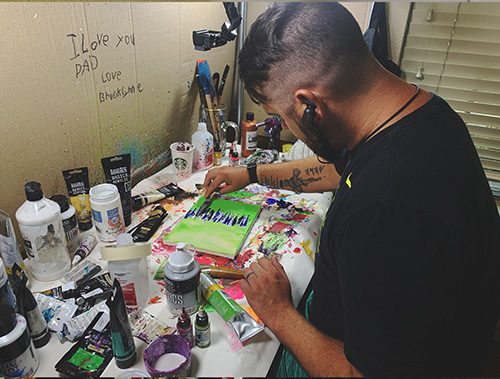
Zeller painting at the custom station built for the TAG project. April 2020.
AS: What happened next?
Initially, I continued a series begun just before his passing called Majestic Shapes. This series explored the loss through the use of simple shapes, their orientation, and “dressing” the shapes with a variety of textures and a similar color palette. It became my first coherent series of seven paintings and depicted the change in status and relationships as the result of his absence.
The pieces in Majestic Shapes were mostly on the large side, up to 4’ x 4’ in dimension. At the time, I preferred working big since it provided optimal room for creative and emotional expression. The collection provided great drama and meaning for me. I was eager to show it publicly.
Fast forward six months, when I held an art show in Vancouver, Washington for a First Friday event. My work was displayed prominently at a real estate office. While the layout of the office was fairly chopped up, the opening room provided a large space to share this series as a grouping for the first time.
As visitors came in to absorb these paintings, I generally left them to their own interpretations before engaging. About halfway into the event, I began mingling more to share insight as to what exactly these rudimentary and textural shapes meant to me. This is when some profound realizations began to occur.
With person after person, I shared my startling story of sudden loss. How one painting depicted my brother’s marriage before and after. Another shared the pride my parents had for their firstborn son. And another illustrated the emotional scars and sense of loss that my sister and I experienced. In this single event, I could not have anticipated the instant connection between friends and strangers. As I shared my own story, people poured out emotion as they reflected on their own loss, or the mere thought of losing someone.
In the weeks and months following the exhibit, I came to realize that while I was indeed processing the externalities of losing my brother, I was avoiding the most important part of it all: what does it mean for me?
This led to the concept of The Art of Grieving which is a year-long painting project. Through this project, I explore and share my own grief as a way to achieve healing through art.
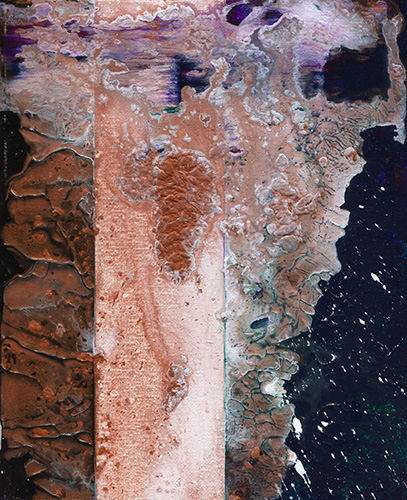
“Day 141″ acrylic on canvas, 8″x 10” (2020)
AS: How big is the scope of your project?
PZ: After completing the Majestic Shapes series and displaying it, I came away with two distinct ideas: first, that sharing my own grief had a therapeutic effect, and secondly, that I still had to do a lot of internal work to process the loss.
In the fall of 2019, I came up with the original idea behind The Art of Grieving (TAG). The initial goal was simple, but big. I would paint every day for an entire year through smaller study paintings to process my grief.
Like any big, hairy, audacious goal, I began publicizing the project in every conversation. Even when I resigned from my tech job and addressed a team of 25 people, I announced it to them. That was step one. I knew there would be many periods of doubt and questioning as I embarked on this journey.
An interesting thing happens when you share big ideas; people contribute to them. What better way to evolve a project than get input from others on what they would like to see?
As a result, the scope quickly turned into a bigger goal, before I even began my first painting.
For the daily paintings, I set some simple parameters:
- The entire process was to be intuitive, in that I would not let overthinking get in the way of creativity. The paintings must flow from an unconscious emotional state.
- I would use 8”x10” canvases consistently throughout the project.
- I would pick colors I felt appropriate for each painting.
- There must be one color (not black or white) from the previous day.
For the broader project, I planned to:
- Paint every day for an entire year
- Document the project by releasing a painting every day on social media
- Film every painting process and create timelapse videos
- Create a related documentary titled The Art of Grieving
- Use my own story as the storyline throughout.
- Interview experts, including Art Therapists, Psychologists, and Grief Counselors.
- Interview others with a story of healing through art or some other activity, about the impact of grief.
- Use AI/machine learning algorithms to find changes in the paintings over time and consult art therapists to find out what’s going on in my mind as I process grief.
- Reveal a 20’x’10’ mosaic comprised of the 365 paintings to give a literal snapshot of a year of grieving.
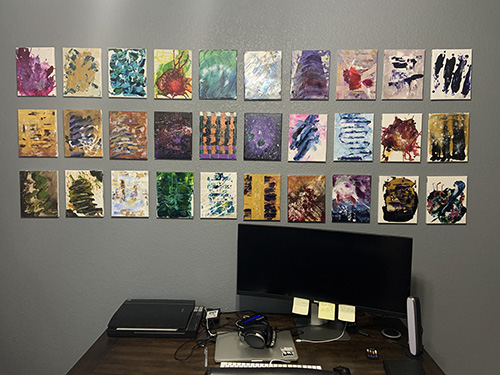
Zeller’s office, where he posts a rolling 30 days of paintings for visual progress.
AS: What have you learned from other people when you shared this work with them?
PZ: Just by sharing the project and my own loss, I’ve had countless conversations with complete strangers, friends, and acquaintances about their own grieving experience. These losses range from sudden to expected, all tough on the person nevertheless – even decades later.
Throughout these interactions, I’ve noticed several distinct things.
There’s no uniform way people deal with grief
Like anything in life, there is a healthy way and an unhealthy way to grieve. While some have defaulted to a healthy output for their grief, others have delved into an unhealthy response where that path did not help the pain, but only numbed it. Either way, grief is an inescapable fact of life once you experience it. The only way out is through. For some, this can mean developing habits that compound and prolong the process.
The impact of death is a rarely discussed topic
In the Western world particularly, emotional hardness is considered sort of a cultural virtue. Bereavement policies across corporate America, even reinforce the idea that 2-3 days and at most a week is enough to be OK with returning to your normal duties. While a week may suffice in some circumstances, I could have easily taken a month to sit with and process this loss, and I’ve heard others agree with that. Simply put, grief is hardly understood or given enough attention in our society.
The process of grieving is much longer than most people think
Given very short-termed bereavement policies and general busyness the general populace consume themselves with, it’s no wonder we think of death as a “here today, gone tomorrow” impact on people’s lives. The reality for everyone I’ve spoken with is that the person’s loss never leaves you. There will always be reminders. An article of clothing, a street sign, a TV show character, a sound, a cardinal in your backyard. These memories never fade.
Death seems far away and even foreign for those who haven’t experienced it
Understandably, if you haven’t lost someone, you’re likely not pondering the impact of it. Maybe it should more often be discussed in light of the importance of a life well-lived. In an individualistic society, death is often perceived as something that only impacts the dead person, but the ripple effects are incredible when someone passes. More discourse on this topic would encourage more empathy and understanding when we encounter those who have lost someone.
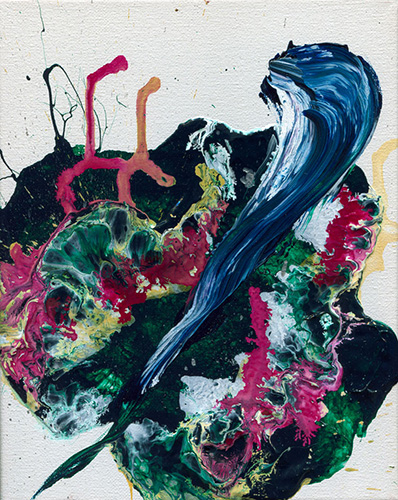
“Day 180″ acrylic on canvas 8″x 10” (2020)
AS: Please share your long-term vision for The Grief Project.
PZ: My sincere hope is to use TAG as a platform for change and discussion around the topic of grief.
Some of my goals are to:
- Develop a better, scientific understanding, of what goes on in the mind after grief
- Proliferate art therapy and general therapy programs designed to deal with moving through the grieving process in a healthy way
- Speak publicly about my own experiences as a catalyst for change
- Change the cultural narrative that grief is a quick process
- Provide better support in the workplace for those experiencing grief
- Lift up others’ success stories into the limelight
Stay updated about the Grief Project here as it moves forward.


Speak Your Mind